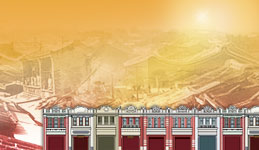          

|
|

|
Lukang
has been the major port of central Taiwan for a long time due to its
geographical superiority. Boats, sampans, and bamboo rafts were used for
transportation at sea. On the other hand, ' No sky' street area, the
primary transportation route of Lukang, also enjoyed numerous means of
transportation for goods transportation, which highlighted the business
nature of ' No sky' street area. The following are different
transportation means on ' No sky' street area of Ching Dynasty and the
Japanese Colonial period, which were also influenced by the restraints
of natural environment.
|
|
 Ching Dynasty
Ching Dynasty
 Bull Wagon
Bull Wagon
Commonly known as bull wagon or bull cart, it is the most common
transportation means in Lukang. During the reign of Kang-His, the bull
wagon is one of the main transportation means of western Taiwan. A bull
wagon can be divided into three parts. The endurance of a bull wagon
depends on the fine quality of the wooden wheels (including the axles),
the first and the most important part of a bull wagon. The second part
is the chassis, and the third is the canvas, which is used for freight.
A bull wagon is simple in structure and manufacturing, and to build one
doesn’t take much time. Unlike Taiwan’s rivers, which travel
transversely, bull wagons were usually used to travel lengthwise, and
thus it became the
primary overland transportation means.
The origin of Nung-Hsu of Nung-Hsu in Lukang (close to He-Hsing Street
and Fu-Hsing Street ) should be able to prove that the bull wagon was
the common transportation means on ' No sky' street area during the
Ching dynasty.
 TOP
TOP |
|
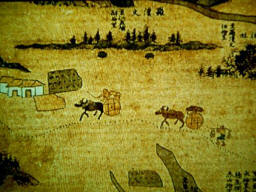 |
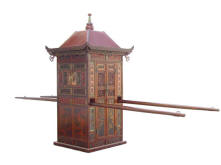 |
|
Bull Wagon |
Sedan Chair |
|
|
 TOP
TOP |
|
 Sedan Chair and Human-Powered Cart
Sedan Chair and Human-Powered Cart
Apart from the bull wagon, the sedan chair and the human-powered cart
were also the two major transportation means on ' No sky' street area.
The sedan chair was a
high-end vehicle, which was used by
rich officials and families. Others hardly used the sedan chair except
for the wedding ceremony. The human-powered cart, like the bull wagon,
is a cheap vehicle and a good means for freight as well. The
human-powered cart is quite small, which makes it suitable for the
narrow streets of Lukang. Thus, it became a popular vehicle for both
business and agriculture.
|
|
 Japanese
Colonial Period Japanese
Colonial Period
There were more transportation means on ' No sky' street area during the
Japanese Colonial Period than during the Ching Dynasty. They received
the old designs and also made some refinements. And the trend was that,
with the development of Japanese colonial economics, there were vehicles
powered by motors, including motorcycles and cars, on ' No sky' street
area at that time.
 Traditional
vehicles Traditional
vehicles
The bull wagon, mostly used in the suburbs, was not a common
transportation means on ' No sky' street area, even though it was a
transportation means of growing popularity. As for the rickshaw, after
the rubber wheels were added to it, it was used only by rich families,
just like the sedan chair. As a result, the rickshaw and the sedan chair
were not common at that time. But the human-powered cart, with its
increasing popularity, was a common transportation means in Hsin-Hsing,
Ta-You-Kou, andTsai-Shih-Tou. (these places are close to ' No sky'
street area)
 New
vehicles New
vehicles
Bicycle
During the reign of Emperor Meiji, the bicycles imported to Taiwan
enjoyed a rapid growth due to the sound development of modern roads.
Therefore, they came with
reasonable prices and became the
most popular vehicle. What bicycles were for people was what the
human-powered cart was for goods. It was the best vehicle for
short-distance traveling. Conceivably, bicycles might have shown up on '
No sky' street area at that time. |
|
 TOP
TOP |
|
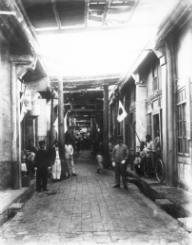 |
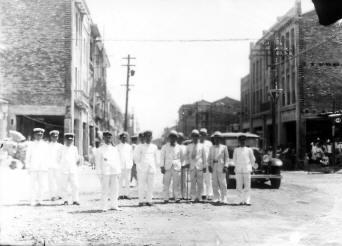 |
|
Bicycle (Near the
flag) |
Cars (behind the
people) |
Motorcycle
The number of motorcycles was scarce compared to that of
bicycles. According to the statistics of that time, there
were 500 something motorcycles, at most, in Taiwan. It was
so
expensive that perhaps
doctors were the only ones that could afford it. The first
motorcycle owner in Lukang was Dr. Hsu Tu. The rest were
also none but doctors. Why? Maybe it was because motorcycles
greatly facilitate their practices. So it might be possible
that the motorcycles raced on ' No sky' street area so as to
help the knights to accomplish their holy missions.
Car
Private-owned cars were almost
nowhere to be found.
Cars were owned by large factories and government sectors.
Judging from the roof of ' No sky' street area, it was
unlikely to drive a car there. And from the pictures we have
at hands, cars are on ' No sky' street area, but that is
because ' No sky' street area was unroofed.
|
|
To sum up, the unique business functions of ' No sky' street
area begot the diversity of transportation means, which
responded to different demands for transportation means. The
innovative vehicles at different times prove the prosperity
of 'No sky' street area. |
|
《Next
Daily life…》 |
|
|

